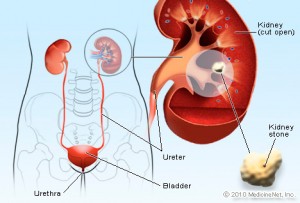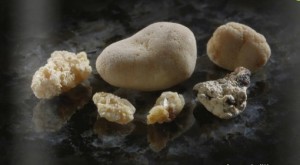
FEATURE COLUMN – The pain usually comes in waves, stabbing and knife-like. No body position – sitting, standing, prone – provides relief. Sometimes the pain is accompanied by nausea, vomiting, fever and chills. Women have even said it hurts worse than childbirth. What can cause this agony? Would you believe that an object the size of a grain of sand can do this?

For those who have not experienced a kidney stone, this may sound unbelievable. On the other hand, many who have had kidney stones understand the pain all too well. I often wonder how those without modern medical care must suffer from kidney stones. Fortunately, we live in an age when many stones can be prevented and those that do form can be treated without major surgery.
What are kidney stones?
Kidney stones usually first appear in men and women ages 20 to 40. Men are three times more likely to have stones than women. However, urine calcium levels rise during pregnancy, making stone formation easier. While “bad genes” are usually not the cause for most people, certain familial kidney diseases do lead to stones. Chronic urinary tract infections can also lead to development of kidney stones.
The single largest cause of kidney stones is dehydration. Stones tend to occur more often in warmer climates. Other causes of kidney stones include sedentary lifestyle, dietary instability and certain medications.
How do I prevent kidney stones?
As mentioned above, dehydration causes most kidney stones. It is especially easy to become dehydrated while living here in the beautiful, yet dry, Southern Utah desert. Increasing oral fluid intake is highly recommended. A good goal (unless your doctor has told you to limit fluids for heart or kidney reasons) is to drink enough fluid to make at least 2.5 liters of urine per day. For the average person, that means six to nine trips to the bathroom per day! It may sound like a hassle, but doing this reduces kidney stone recurrence by 50 percent.
A recent study confirms that water is best. Cola drinks were found to cause stones, both those with sugar or artificial sweeteners. If you don’t like drinking water, then the next best option is to flavor your water with lemon.
You may have heard that if you have kidney stones, you need to avoid food containing dairy. This is not true. Although most kidney stones contain calcium, simply reducing or eliminating calcium from your diet is not recommended. In fact, people who form calcium stones who drastically reduce dietary calcium actually form more stones in the future.

People who form frequent kidney stones should have more extensive evaluation by a doctor. This may include blood and urine testing to determine the cause. Occasionally, we find parathyroid tumors or other seemingly unrelated but important causes for recurrent kidney stones. How can I tell if I have a kidney stone?
Kidney stone pain can vary in severity and location. Pain may not be present at all if the stone is not blocking urine flow. Kidney stones usually become painful when they enter the ureter (the small tube that connects a kidney to the bladder.) When the stone is higher in the ureter, pain usually occurs in the flank on the side of the stone. Nausea and vomiting may occur as well. If the urine trapped behind the stone becomes infected, then fever and shaking chills could occur.
If stones are small enough, they can progress down the ureter toward the bladder. As they do this, the pain can migrate to the front of the abdomen and pelvis on the side of the stone. Pain may radiate down to the genital area too.
What can be done for my kidney stone?
If kidney stones pass to the bladder, then usually the hard part is over. Typically, they can pass from the bladder very easily. If stones are stuck in the kidney or ureter, then a urologist may need to help. Certain medication can loosen the muscular wall of the ureter, increasing the likelihood of passing stones.
Surgical options are usually minimally invasive. Depending on the size and location of the stone, it can be broken up with shock waves, lasers or simply removed with a basket (all done without an incision.) Larger stones may need more invasive procedures where the stone may need to be removed through an incision.
Prevent if you can, treat if you must
I met a man once who had open heart surgery and then a kidney stone. He said that he’d rather have another open heart surgery than experience kidney stone pain again. His ordeal underscores the need for prevention. Let’s all prevent kidney stones by staying well-hydrated this summer!
Written by Dr. Gregory S. Taylor, physician at St. George Urology, for St. George Health and Wellness magazine and St. George News.
St. George Health and Wellness
Email: [email protected]
Twitter: @STGnews
Copyright St. George News, StGeorgeUtah.com Inc. and St. George Health and Wellness magazine, 2013, all rights reserved.
I have had 3. I have never felt so much pain as a kidney stone. It feels like you have been stabbed in the back with a pole. I have found adding lemon juice to water helps prevent them.
I have been a chiropractor for 18 years. I can’t count the number of times patients have come in complaining of lower back pain then after examination I determine that they have kidney stones. There is nothing I can do for them. I have to refer them out. They tend to leave the office disappointed that I can’t help their pain. But I try to explain that kidney pain can refer pain to the back and spine.
Kidney stones feel like a walk in the park compared to a twisted bowel. Now that is something you could say hurts worse than labor.
We spent 6 wonderful weeks in Northern Arizona and Utah this past August and September, marred only by passage of a stone on 15 September, right before coming home. But since arriving home I have passed 23 more, ranging from 2 to 5mm. I stayed well hydrated and continue to drink a lot of fluid. But evidently a lot is still not enough. I just want to be done with it!
I am REALLY thirsty right now! I have passed a couple of kidney stones and I have been hit in the eye with a golf ball resulting in the total loss of that eye. I can honestly say that, if I had another eye to spare, I’d rather be hit with another golf ball!! I have been shot and cut with a knife and I have hit my thumb with a hammer numerous times – nothing has ever hurt as much as that kidney stone! I will drink a lot of water from now on!!